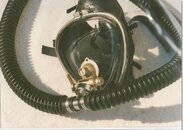David Wilson
Contributor
In 1960, before Siebe-Gorman merged with Heinke, the company offered a model of adjustable fins called the "Essgee". The product name derived from the initial letters of Siebe-Gorman, "SG".
Essgee Adjustable fins


The images above leave me at least with a sense of déjà vu. You may recall Dunlop Aquafort fins:


My take on this resemblance is that Siebe-Gorman took delivery of Dunlop's surplus stock of basic gear after the latter was minded to discontinue its Aquafort range of recreational diving equipment in the early 1960s. This would explain the appearance of Dunlop's fixed-heel Admiralty pattern fins in Siebe-Gorman's 1960s catalogues. Or perhaps somebody knows different? If so, please speak up!
The Siebe-Heinke catalogues of 1963 and 1964 also offered Heinke's old line of Hans Hass fins:

We've reviewed these already in the "Heinke" section of this thread. A final word on fins in Siebe-Gorman's catalogues. The 1969 catalogue offers "Sea King" swimfins in floating and non-floating versions:

The catalogue contains no illustration of these fins. "Sea King" is the name of a popular fin made by the Italian diving equipment manufacturer Mares. The model was available in 1969, leading to the hypothesis that Siebe-Gorman "carried" these fins. Anyway here are some pictures of the Mares "Sea King" fin:



We'll move on soon to Siebe-Gorman diving masks.
Essgee Adjustable fins
The images above leave me at least with a sense of déjà vu. You may recall Dunlop Aquafort fins:
My take on this resemblance is that Siebe-Gorman took delivery of Dunlop's surplus stock of basic gear after the latter was minded to discontinue its Aquafort range of recreational diving equipment in the early 1960s. This would explain the appearance of Dunlop's fixed-heel Admiralty pattern fins in Siebe-Gorman's 1960s catalogues. Or perhaps somebody knows different? If so, please speak up!
The Siebe-Heinke catalogues of 1963 and 1964 also offered Heinke's old line of Hans Hass fins:
We've reviewed these already in the "Heinke" section of this thread. A final word on fins in Siebe-Gorman's catalogues. The 1969 catalogue offers "Sea King" swimfins in floating and non-floating versions:
The catalogue contains no illustration of these fins. "Sea King" is the name of a popular fin made by the Italian diving equipment manufacturer Mares. The model was available in 1969, leading to the hypothesis that Siebe-Gorman "carried" these fins. Anyway here are some pictures of the Mares "Sea King" fin:
We'll move on soon to Siebe-Gorman diving masks.





